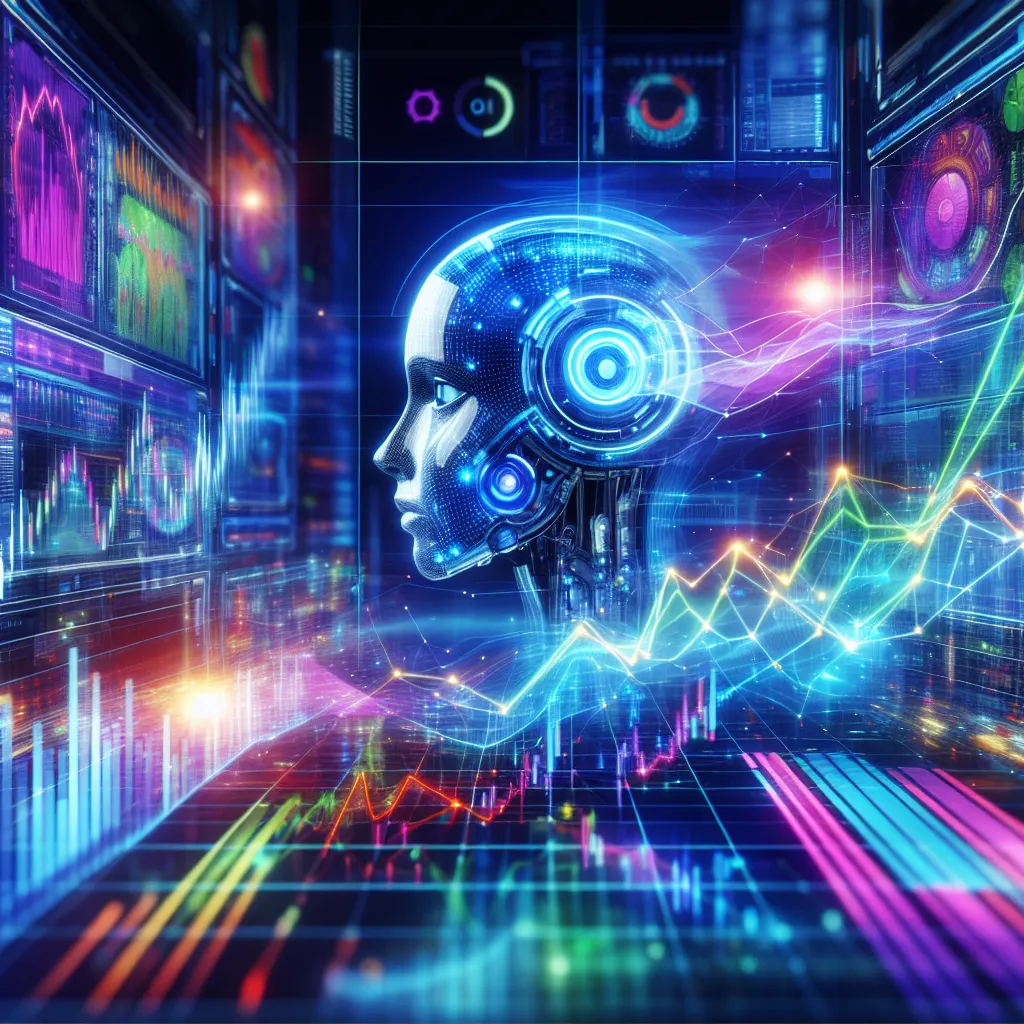The IELTS Reading section often includes passages on cutting-edge technological advancements and their societal impacts. One such topic that has gained significant traction in recent years is the influence of Artificial Intelligence (AI) on economic forecasting. This subject combines elements of technology, economics, and data science, making it a prime candidate for IELTS Reading passages. Based on the increasing prevalence of AI-related topics in academic and professional discourse, it’s highly likely that test-takers may encounter similar themes in future IELTS exams.
Let’s dive into a practice reading passage that explores the transformative role of AI in economic predictions, followed by a set of questions to test your comprehension and analytical skills.
 AI Economic Forecasting
AI Economic Forecasting
Reading Passage: The Revolutionary Impact of AI on Economic Forecasting
Paragraph 1
Artificial Intelligence (AI) is revolutionizing numerous fields, and economic forecasting is no exception. Traditional economic prediction methods have long relied on complex mathematical models and human expertise. However, these approaches often struggle to capture the intricate dynamics of modern economies, leading to forecasts that can be inaccurate or outdated by the time they’re published. Enter AI, with its ability to process vast amounts of data at unprecedented speeds and identify patterns that human analysts might overlook.
Paragraph 2
One of the key advantages of AI in economic forecasting is its capacity to analyze diverse data sources simultaneously. While conventional methods typically focus on a limited set of economic indicators, AI systems can incorporate a wide array of inputs. These may include traditional economic data, social media trends, satellite imagery, and even real-time consumer behavior patterns. By synthesizing this diverse information, AI can provide a more comprehensive and nuanced view of economic trends.
Paragraph 3
Machine learning, a subset of AI, has proven particularly effective in improving the accuracy of economic predictions. These algorithms can learn from historical data, continuously refining their forecasts as new information becomes available. This adaptability is crucial in today’s rapidly changing economic landscape, where global events can quickly alter market conditions. Machine learning models can adjust their predictions in real-time, providing policymakers and businesses with up-to-date insights to inform their decisions.
Paragraph 4
The application of AI in economic forecasting extends beyond merely predicting broad economic trends. It’s increasingly being used to forecast specific sector performance, identify potential market disruptions, and even predict individual company outcomes. For instance, AI algorithms can analyze supply chain data to anticipate potential shortages or disruptions, allowing businesses to proactively adjust their strategies. This granular level of prediction was previously unattainable with traditional forecasting methods.
Paragraph 5
However, the integration of AI into economic forecasting is not without challenges. One significant concern is the potential for AI systems to perpetuate or amplify existing biases present in historical economic data. If not carefully designed and monitored, AI algorithms could reinforce inequalities or overlook important socio-economic factors. Additionally, the ‘black box’ nature of some AI models can make it difficult for economists to understand and explain the reasoning behind certain predictions.
Paragraph 6
Despite these challenges, the potential benefits of AI in economic forecasting are too significant to ignore. As AI technology continues to evolve, we can expect even more sophisticated and accurate economic predictions. This could lead to more informed policy decisions, better resource allocation, and increased economic stability. The future of economic forecasting likely lies in a hybrid approach, combining the analytical power of AI with human expertise and judgment to create more robust and reliable economic predictions.
Questions
True/False/Not Given
- Traditional economic forecasting methods are always accurate and up-to-date.
- AI can analyze a wider range of data sources compared to conventional forecasting methods.
- Machine learning algorithms in economic forecasting can adapt to new information in real-time.
- AI is only useful for predicting broad economic trends, not specific sector performance.
- The use of AI in economic forecasting is completely free from challenges or concerns.
Multiple Choice
-
According to the passage, which of the following is a key advantage of AI in economic forecasting?
A) It eliminates the need for human economists
B) It can process vast amounts of data quickly
C) It is always 100% accurate in its predictions
D) It reduces the cost of economic forecasting -
What concern does the passage mention regarding the use of AI in economic forecasting?
A) AI systems might be too slow to process economic data
B) AI could potentially perpetuate existing biases in historical data
C) AI is too expensive for widespread adoption
D) AI cannot handle complex economic models
Matching Headings
Match the following headings to the appropriate paragraphs in the passage. You may use each heading only once.
- Paragraph 2
- Paragraph 4
- Paragraph 6
Headings:
A) Challenges in Implementing AI for Economic Forecasting
B) The Future of AI in Economic Predictions
C) Diverse Data Sources Enhancing Forecast Accuracy
D) Granular Predictions and Sector-Specific Forecasting
Short Answer Questions
Answer the following questions using NO MORE THAN THREE WORDS from the passage for each answer.
- What type of AI is mentioned as being particularly effective in improving the accuracy of economic predictions?
- Besides economic indicators, what two examples of alternative data sources does the passage mention that AI can analyze?
- What term is used to describe the difficulty in understanding the reasoning behind some AI models’ predictions?
Answer Key and Explanations
-
False
Explanation: The passage states that traditional methods “often struggle to capture the intricate dynamics of modern economies, leading to forecasts that can be inaccurate or outdated.” -
True
Explanation: The passage mentions that “AI systems can incorporate a wide array of inputs” compared to conventional methods that “typically focus on a limited set of economic indicators.” -
True
Explanation: The text states that machine learning models “can adjust their predictions in real-time.” -
False
Explanation: The passage explicitly states that AI is “increasingly being used to forecast specific sector performance.” -
False
Explanation: The passage discusses several challenges and concerns associated with using AI in economic forecasting. -
B
Explanation: The passage mentions AI’s “ability to process vast amounts of data at unprecedented speeds” as a key advantage. -
B
Explanation: The passage states, “One significant concern is the potential for AI systems to perpetuate or amplify existing biases present in historical economic data.” -
C
Explanation: Paragraph 2 discusses how AI can analyze diverse data sources, enhancing forecast accuracy. -
D
Explanation: Paragraph 4 focuses on how AI can provide granular predictions and sector-specific forecasting. -
B
Explanation: Paragraph 6 discusses the future potential of AI in economic forecasting. -
Machine learning
Explanation: The passage states, “Machine learning, a subset of AI, has proven particularly effective in improving the accuracy of economic predictions.” -
Social media trends
Explanation: The passage mentions “social media trends” and “satellite imagery” as examples of alternative data sources. -
Black box
Explanation: The passage refers to the “‘black box’ nature of some AI models” when discussing difficulties in understanding AI predictions.
Common Mistakes to Avoid
-
Overlooking specific details: Many test-takers might miss nuanced information, such as the challenges associated with AI in economic forecasting. Always read the passage carefully and pay attention to both positive and negative aspects presented.
-
Falling for distractors: In multiple-choice questions, some options may seem plausible but are not supported by the passage. Always refer back to the text to verify your answers.
-
Misinterpreting True/False/Not Given questions: Remember, “Not Given” means the information is neither confirmed nor contradicted by the passage. Don’t make assumptions based on your own knowledge.
-
Exceeding word limits: In short answer questions, stick strictly to the word limit given. Using more words than allowed will result in a wrong answer, even if the content is correct.
-
Ignoring context: When matching headings or answering questions, consider the entire paragraph or section, not just isolated sentences.
Vocabulary Focus
- Revolutionizing: (verb) causing a complete or dramatic change
- Intricate: (adjective) very complicated or detailed
- Unprecedented: (adjective) never done or known before
- Synthesizing: (verb) combining different ideas, influences, or objects into a new whole
- Nuanced: (adjective) characterized by subtle shades of meaning or expression
- Granular: (adjective) characterized by a high level of detail or precision
- Perpetuate: (verb) make something continue indefinitely
- Amplify: (verb) increase the volume, amount, or strength of something
Grammar Spotlight
Pay attention to the use of conditional sentences in the passage, such as:
“If not carefully designed and monitored, AI algorithms could reinforce inequalities or overlook important socio-economic factors.”
This is an example of a first conditional sentence, used to express a real possibility in the future. The structure is:
If + present simple, will/can/could + infinitive
This structure is commonly used in academic writing to discuss potential outcomes or consequences.
Tips for IELTS Reading Success
-
Practice active reading: As you read, mentally summarize each paragraph and identify the main idea.
-
Improve your vocabulary: Regularly learn new words and their contexts, especially in fields like technology and economics.
-
Time management: Allocate your time wisely across all sections of the reading test. Don’t spend too long on any single question.
-
Skim and scan effectively: Quickly identify where in the passage to find specific information for answering questions.
-
Read the questions carefully: Ensure you understand exactly what each question is asking before searching for the answer.
-
Use contextual clues: If you encounter unfamiliar words, try to deduce their meaning from the surrounding context.
-
Practice regularly: Consistent practice with various types of passages and question formats will improve your speed and accuracy.
Remember, success in IELTS Reading comes from a combination of strong English language skills, effective test-taking strategies, and familiarity with a wide range of topics. Keep practicing and stay informed about current affairs, especially in areas like technology and its societal impacts.
For more practice on IELTS Reading, you might find our articles on AI’s role in supply chain optimization and how AI is transforming environmental monitoring helpful. These topics are closely related to AI’s impact on various sectors and can broaden your understanding of AI applications in different fields.


